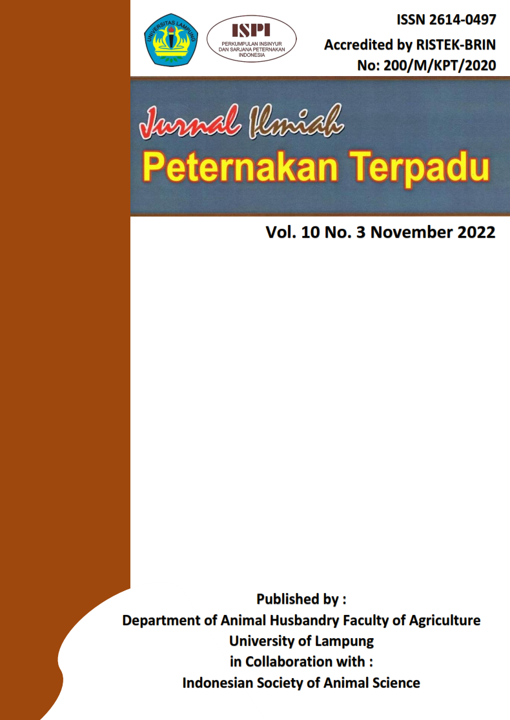Improvement of Water Hyacinth (Eichhornia crassipes) Quality as Animal Feed through Fermentation Using Rumen Microbes with the Addition of Molasses
DOI:
https://doi.org/10.23960/jipt.v10i3.p313-322 Abstract View: 510
Abstract View: 510
Keywords:
Crude fiber, Crude protein, Fermentation time, Molasses, Water hyacinthAbstract
One of the potential alternative feed ingredients as animal feed is water hyacinth. However, the low quality and palatability cause water hyacinth not being liked by ruminants. One way to improve the quality of water hyacinth is using controlled technology involving rumen microbes. The purpose of the study was to determine the level of addition of molasses and fermentation time in improving the quality of water hyacinth using rumen microbes through the test parameters for crude protein and crude fiber content. This study used a completely randomized design (CRD) with factorial patterns with molasses levels, namely M1 = 5%, M2 = 10%, M3 = 15%, and fermentation time consisting of T1 = 7 days, T2 = 10 days, T3 = 13 days . Each experimental design was repeated 3 times to form 27 experimental units. Data were analyzed using variance, if there was a significant treatment effect (P<0.05), followed by the HSD test on the average treatment. The results showed that the highest crude protein content was 14.23% in the M2T3 treatment (10% molasses level with 13 days of fermentation time) (P<0.05) while the lowest crude fiber was 14.55% in the M3T2 treatment (15% molasses level with a dangerous time) 10 days). This treatment was significantly different (P<0.05) from the other treatments. The results of the study concluded that the addition of 10% molasses for 13 days of brewing time could increase the crude protein content in water hyacinth fermented using rumen-filled microbes.and the lowest decrease in crude fiber was at 15% molasses level with 10 days of fermentation.
Downloads
References
Ali, M.R.B., Pratomo, D., Burhanuddin, H., Ayuningsih, B., Dhalika, T., Mansyur, and Hernaman, I. 2020. Pengaruh Lama Fermentasi dan Pemberian Aditif Molases atau Lumpur Kecap terhadap Fermentabilitas dan Kandungan Protein Kasar Silase Rumput Gajah Cv. Taiwan. Jurnal Ilmu Ternak 20(1):81-86.
Alvianto, A., Muhtarudin., and Erwanto. 2015. Pengaruh penambahan berbagai jenis sumber karbohidrat pada silase limbah sayuran terhadap kualitas fisik dan tingkat palatabilitas silase. Jurnal Ilmiah Peternakan Terpadu 3(4): 196-200. DOI: http://dx.doi.org/10.23960/jipt.v3i4.p%25p
AOAC. 2005. Official Methods of Analysis of AOAC International. 19th edition. Association of Official Analytical Chemist (AOAC) 54 International, Gaithersburg, Maryland, USA.
Aryanta, I. W. R. 2013. Mikrobiologi pakan dan pangan. Udayana University Press, Denpasar.
Bidura, I. G. N. G. 2007. Aplikasi Produk Bioteknologi Pakan Ternak. Udayana University Press, Denpasar.
Dhalika, T., Budiman, A., and Tarmidi, A. R. 2021. Pengaruh Penambahan Molases pada Proses Ensilase terhadap Kualitas Silase Jerami Ubi Jalar (Ipomoea batatas). Jurnal Ilmu Ternak 21(1):33-39. DOI: https://doi.org/10.24198/jit.v21i1.33105
Dehority, B. A. 2004. Rumen Microbiology. Nottingham University Press, Nottingham.
Fahmi, A. N. 2013. Pengaruh Penambahan Molases terhadap Kandungan Protein Kasar dan Serat Kasar Padatan Lumpur Organik Unit Gas Bio. Skripsi. Fakultas Peternakan Universitas Brawijaya. Malang.
Fajarudin, M. W., Junus, M., and Setyowati, E. 2013. Pengaruh Lama Fermentasi EM-4 terhadap Kandungan Protein Kasar Padatan Kering Lumpur Organik Unit Gas Bio. Jurnal Ilmu-Ilmu Peternakan 23 (2): 14-18.
Gunnarsson, C. C. and Petersen, C. M. 2007. Water Hyacinths as a Resource in Agriculture and Energy Production: A literature review. Waste Management 27(1):117-129. https://doi.org/10.1016/j.wasman.2005.12.011
Ismi, R.S., Pujaningsih, R.I., and Sumarsih, S. 2017. Pengaruh Penambahan Level Molases terhadap Kualitas Fisik and Organoleptik Pelet Pakan Kambing Periode Penggemukan. Jurnal Ilmiah Peternakan Terpadu 5(3):58-63. DOI: https://doi.org/10.23960/jipt.v5i3.2462
Larangahen, A., Bagau, B., Imbar, M.R., and Liwe, H. 2017. Pengaruh Penambahan Molases terhadap Kualitas Fisik dan Kimia Silase Kulit Pisang Sepatu (Mussa paradisiaca formatypica). Jurnal Zootek 37(1): 156-166. DOI: https://doi.org/10.35792/zot.37.1.2017.14419
Mirsal. 2019. Aceh Barat berpotensi jadi produsen pakan eceng gondok. Antaranews Aceh. https://aceh.antaranews.com/berita/57526/aceh-barat-berpotensi-jadi-produsen-pakan-eceng-gondok. Diakses 1 Agustus 2022.
Nainggolan, E.A., Situmeang, R. C. and Silitonga, A. 2018. Fermentasi Eceng Gondok (Eichonia crasssipes) menggunakan Effective Microorganism 4 (EM4). In: Prosiding Seminar Nasional Penelitian dan Pengabdian pada Masyarakat. ISBN : 978-602. Pp.76-79
Parveen, K. and Pandey, A. 2018. Effect of Water Hyacinth Compost on Pond Productivity and Gut Content of Rohu (Labeo Rohita) Fry. Journal of Entomology and Zoology Studies 6(3):1455-1460.
Poulsen, M., Schwab C., Jensen, B. B., Engberg, R. M., Spang, A., Canibe, N., Heiberg, O., Milinovich, G., Fragner, L., Scleper, C.,Weckwerth, W., Lund, P., Schram, A., and Urich, T. 2013. Methylotrophic methanogenic Thermoplasmata implicated in reduced methane emissions from bovine rumen. Nature Communications 4:1–9. DOI: https://doi.org/10.1038/ncomms2432
Rahayu, W. P. and Nurwitri, C. C. 2019. Mikrobiologi Pangan. PT. IPB Press. Bogor
Tillman, A. D., Hartadi, H., Reksohadiprodjo, S., Prawirokusumo, R. and Labdosoekojo, S. 1998. Ilmu Makanan Ternak Dasar. Gadjah Mada University Press, Yogyakarta. 417 hal.
Wuysang, S., Rahasia, C. A,. Umboh, J. F., Tulung, Y. L. R. 2017. Pengaruh Penggunaan Molases sebagai Sumber Energi Pakan Penguat dalam Ransum terhadap Pertumbuhan Ternak Kelinci. Jurnal Zootek 37(1) : 149-155.
Downloads
Published
How to Cite
Issue
Section
License

Jurnal Ilmiah Peternakan Terpadu(JIPT) is licensed under a Creative Commons Attribution 4.0 International License.
Authors who publish with this journal agree to the following terms:
- Authors retain copyright and grant the journal right of first publication with the work simultaneously licensed under a Creative Commons Attribution License that allows others to share the work with an acknowledgement of the work's authorship and initial publication in this journal.
- Authors are able to enter into separate, additional contractual arrangements for the non-exclusive distribution of the journal's published version of the work (e.g., post it to an institutional repository or publish it in a book), with an acknowledgement of its initial publication in this journal.
- Authors are permitted and encouraged to post their work online (e.g., in institutional repositories or on their website) prior to and during the submission process, as it can lead to productive exchanges, as well as earlier and greater citation of published work (See The Effect of Open Access).





















